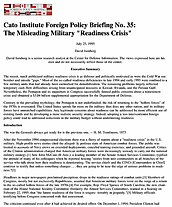Contrary to the prevailing mythology, the Pentagon is not underfunded; the risk of returning to the “hollow forces” of the 1970s is overstated. The United States spends far more on the military than does any other nation, and its military forces have unmatched capabilities. Any legitimate concerns about readiness can be addressed by more efficient use of existing funds and by developing a more realistic security strategy. Indeed, adopting a less interventionist foreign policy could lead to additional reductions in the military budget without undermining readiness.
The Misleading Military “Readiness Crisis”
The recent, much publicized military readiness crisis is as dubious and politically motivated as were the Cold War era bomber and missile “gaps.” Most of the so-called readiness deficiencies in late 1994 and early 1995 were confined to a few military units that had already been earmarked for demobilization. The remaining problems largely reflected temporary cash-flow difficulties arising from unanticipated missions in Kuwait, Rwanda, and the Persian Gulf. Nevertheless, the Pentagon and its supporters in Congress successfully fanned public concerns about a nonexistent crisis and obtained a $3.04 billion supplemental appropriation for the Department of Defense.

This work is licensed under a Creative Commons Attribution-NonCommercial-ShareAlike 4.0 International License.

